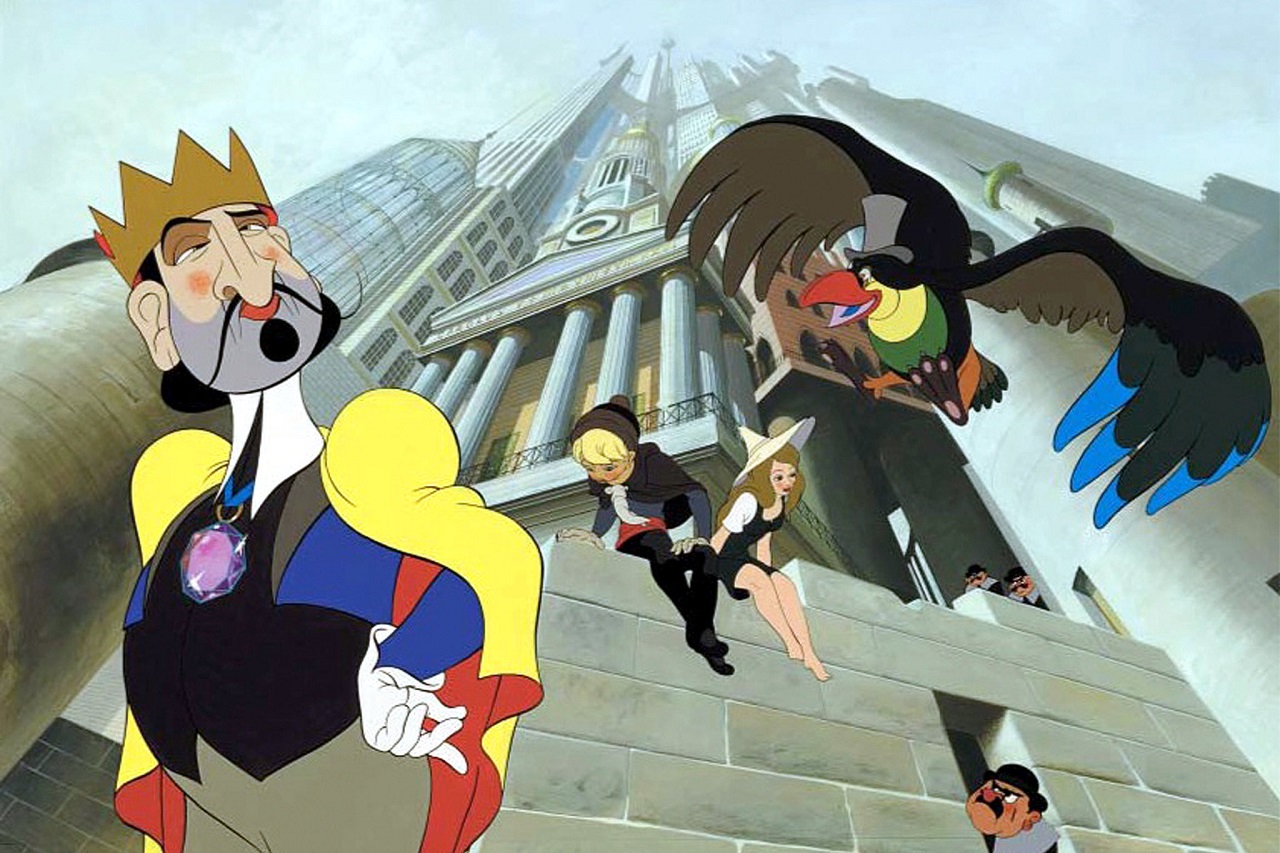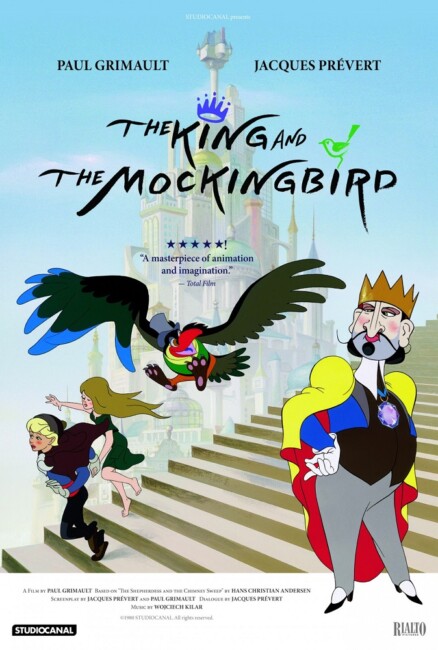aka The Curious Adventure of Mr Wonderbird; The King and the Bird; The Shepherdess and the Chimneysweep
(Le Roi et L’Oiseau)
Crew
Director/Production Design – Paul Grimault, Screenplay – Paul Grimault & Jacques Prevert, Based on the Fairy-Tale The Shepherdess and the Chimney Sweep by Hans Christian Andersen, Photography – Gerard Soraint, Music – Wojciech Kilar. Production Company – Paul Grimault Films/Gibe Films/Antenne 2
Voices
Jean Martin (The Bird), Pascal Mazzotti (The King), Renaud Marx (The Chimneysweep), Agnes Viala (The Shepherdess), Roger Blin (The Blind Man), Raymond Bussieres (The Police Chief)
Plot
A bird tells the story of the cruel and much disliked King V + III = VIII + VIII = XVI of Takicardia. In the paintings in the king’s bedchamber, a shepherdess and a chimneysweep came to life, emerged from the painting and ran away to discover the outside world together. A portrait of the king, who wanted to marry the shepherdess, also came to life, disposed of the real king, took his place and then pursued the shepherdess and chimneysweep with the king’s police force. However, the bird and its children came to the aid of the two lovers.
The King and the Mockingbird, which is the most recognised among this film’s various international retitlings, is a classic work of French animation. The film’s director and principal creative force Paul Grimault was an animator who began working in the 1930s. Grimault made only ten short animated films during his lifetime and The King and the Mockingbird was his sole feature-length film. The King and the Mockingbird has become an obscure classic that is gradually becoming more well-known.
Part of the reason for the obscurity of The King and the Mockingbird is the film’s troubled production history. Paul Grimault began working on on the film in 1948 where he had intended it to be France’s first feature-length animated film. The film suffered from production and financing troubles and was eventually beaten out in becoming the first French feature-length animation by Johnny the Giant Killer (1950). Grimault had a major falling out with his producing partner Andre Sarrut after Sarrut showed an uncompleted version of of the film in 1952. The ownership of The King and the Mockingbird was fought over for fifteen years with Grimault finally regaining the material back in 1967. It would be nearly as long a period of time before audiences managed to see the completed film in 1980.
Finally seen, The King and the Mockingbird is a major discovery. It is often claimed that the film influenced master Japanese animator Hayao Miyazaki, director of Princess Mononoke (1997), Spirited Away (2001) et al. You can see the similarities to Miyzaki in the boldness of storytelling, the painterly use of colours and the wondrous contrasts of big scale and the touchingly small. Certainly, if you compare The King and the Mockingbird to pretty much any other film that was being made around the time, they pale in comparison – Disney had had their classic era during the period 1937-42 but nowhere else were animated films with such vision being made.

There is a lovely beauty to The King and the Mockingbird. Especially dazzling are the backgrounds of the film – all amazing architecture-defying parapets, rooftops and towers. Indeed, the palace is almost its own character in the film. There are some magical pieces of animation – especially delightful being the scenes with the blind violinist charming the lions or with king rampaging about inside a giant robot.
In other ways, the film is slightly flatter than what we are used to today. The hero and heroine are lacklustre characters and never particularly come to life – today they would be much livelier and more rounded and almost certainly the romance would be pushed to the forefront of the film. The king however is a wonderfully pompous character who shines throughout, while the bird narrator is an engaging character.
The King and the Mockingbird is often seen as a political work in the light of the career of screenwriter Jacques Prevert who wrote several other films around this time, most notably The Devil’s Envoys (1942), which was a direct allegory for Wartime occupation by the Nazis. The King and the Mockingbird is seen in terms of the King representing corrupt and decadent authority, although it should be said that such pompous figures feature regularly in animation and that the argument for allegory is a slight one.


